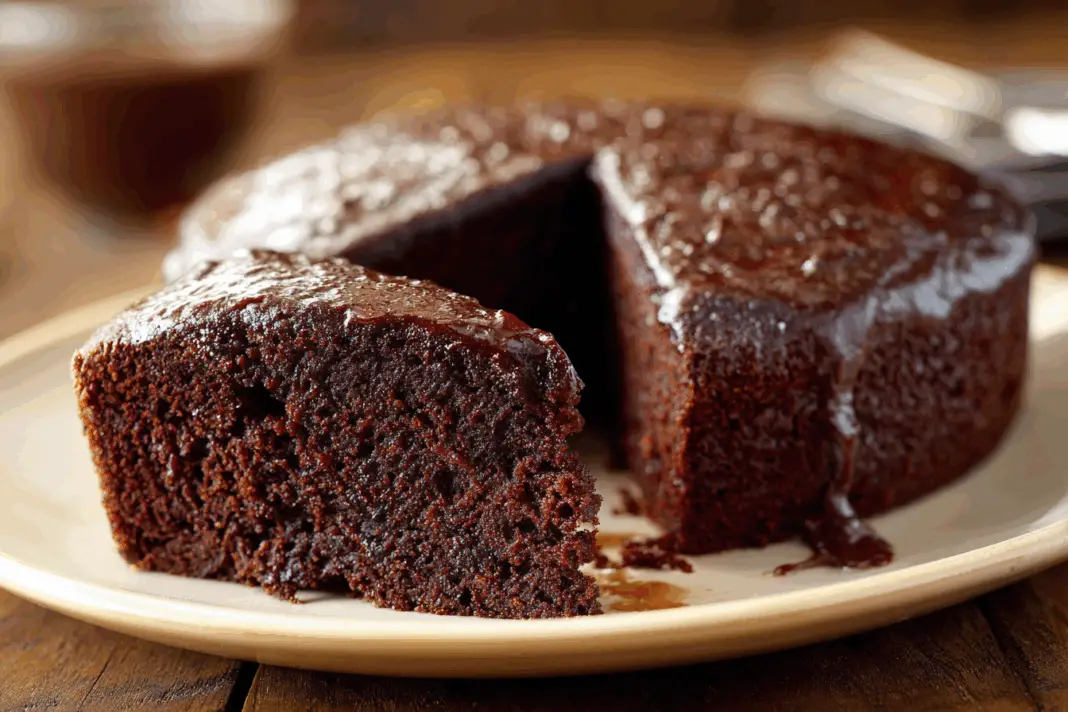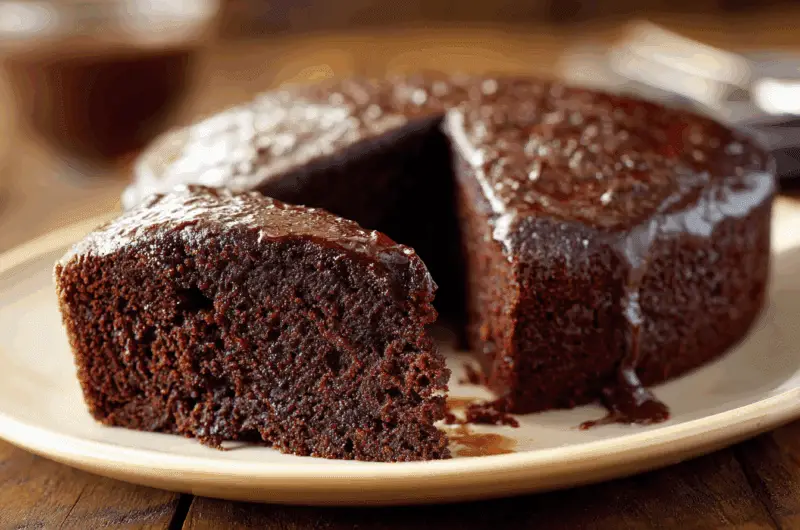Ever baked a chocolate cake that turned out dry and crumbly despite following the recipe perfectly? Most home bakers have been there, staring at what should have been a moist, decadent dessert but instead got something that needed a glass of milk just to swallow. The secret to incredibly moist cakes might already be sitting in your refrigerator – and it’s not what most people would expect.
Mayonnaise actually makes chocolate cake incredibly moist
It sounds completely weird, but mayonnaise is one of the best-kept secrets for creating super moist chocolate cake. This trick dates back to the 1940s when household ingredients were rationed during World War II, and resourceful bakers discovered that mayo worked as an excellent substitute for eggs and oil. The reason it works so well is simple – mayonnaise contains the same basic ingredients that make cakes tender: eggs, oil, and a bit of acid.
When professional bakers use this technique, they typically replace the eggs in their recipe with mayo rather than adding it on top of everything else. Using mayo creates an emulsified mixture that holds moisture better than traditional methods. For most chocolate cake recipes, about 1/4 cup of mayonnaise replaces one large egg, and the results are dramatically moister without any weird aftertaste.
Leftover mashed potatoes work as a moisture booster
Before throwing out those leftover mashed potatoes from dinner, consider adding a few tablespoons to your next cake batter. Root vegetables like potatoes and carrots naturally hold moisture extremely well, which makes them perfect for creating dense, moist cakes. Professional bakers have been using this technique for years, especially in chocolate and spice cakes where the extra density actually improves the overall texture.
The starch in potatoes acts like a sponge, trapping moisture and keeping it locked in even after baking. Celebrity baker Duff Goldman swears by this method and recommends adding just a few tablespoons to avoid overwhelming the other ingredients. The potatoes completely disappear into the cake batter, leaving behind only incredible moisture and a slightly denser crumb that many people actually prefer over lighter, airier cakes.
Buttermilk beats regular milk every single time
Regular milk might seem like the obvious choice for cake baking, but buttermilk creates noticeably moister results. The acidity in buttermilk breaks down gluten proteins, which creates a more tender crumb structure. This chemical reaction also helps other leavening agents work more effectively, resulting in cakes that rise properly while staying incredibly soft and moist throughout.
Many experienced bakers automatically substitute buttermilk whenever they see regular milk listed in cake recipes. Professional bakers know that buttermilk also adds a subtle tangy note that balances the sweetness in cake batter, creating more complex and interesting results. The slight acidity also helps preserve moisture longer, which means cakes made with buttermilk stay fresh and moist for several days instead of drying out overnight.
Instant pudding mix contains a secret moisture ingredient
Adding a small box of instant pudding mix to cake batter might sound like cheating, but it actually contains a professional-grade ingredient called Instant Clearjel. This modified cornstarch helps cakes retain significantly more moisture than traditional recipes. The pudding mix essentially acts like a moisture insurance policy, ensuring that even slightly overbaked cakes stay tender and soft.
Instant Clearjel is the same ingredient that commercial bakeries use to keep their cakes moist for days on store shelves. Bakery owners rely on this technique because it creates consistent results every time. The pudding mix also adds extra richness without making the cake overly sweet, and it works especially well in vanilla, chocolate, and spice cake recipes where the pudding enhances rather than competes with existing ingredients.
Vegetable oil beats butter for moisture retention
Butter definitely wins in the taste department, but vegetable oil creates moister cakes that stay soft even when refrigerated. The science is straightforward – oil remains liquid at room temperature while butter solidifies, which means oil-based cakes maintain their tender texture regardless of storage temperature. Smart bakers often use a combination of both butter and oil to get maximum taste and moisture.
This technique works particularly well for chocolate cakes, where cocoa powder tends to absorb moisture and create drier results. Professional bakers typically replace about half the butter with an equal amount of vegetable oil, which provides the perfect balance between rich taste and soft texture. The oil also helps distribute moisture more evenly throughout the batter, preventing those frustrating dry spots that sometimes appear in butter-only cakes.
Lower oven temperatures prevent moisture loss
Most home bakers set their ovens too high, which causes moisture to evaporate quickly and creates dry, tough cakes. Professional bakeries typically bake cakes at much lower temperatures – around 300 to 325 degrees instead of the 350 degrees that many recipes suggest. This slower baking process allows moisture to stay trapped inside while the cake structure sets properly.
Lower temperatures also prevent the edges from cooking too quickly, which eliminates those annoying crispy borders that many home-baked cakes develop. Experienced bakers recommend using an oven thermometer to ensure accuracy, since many home ovens run hotter or cooler than their dials indicate. The extra baking time is worth it for the dramatically improved moisture and texture that slower baking provides.
Sheet pan baking eliminates dry edges completely
Baking cakes in large sheet pans instead of round cake pans completely eliminates the problem of dry, overcooked edges. This professional technique involves baking the entire cake as one large, thin layer, then using cake rings to cut out perfectly round layers. Every piece of the finished cake comes from the moist center section, with no tough edges to trim away.
This method also allows for more even heat distribution, which means no more worrying about hot spots or uneven baking. Many professional bakeries use this technique exclusively because it provides consistently moist results and reduces waste. The sheet pan method works especially well for layer cakes, where multiple thin layers actually create better moisture distribution than fewer thick layers.
Simple syrup seals in existing moisture
A light coating of simple syrup on finished cake layers acts like a moisture seal, preventing existing dampness from evaporating. This technique works best when the cake is already moist from other methods – syrup can’t fix a dry cake, but it can make a good cake stay perfect longer. Professional bakers routinely brush simple syrup on every layer before adding frosting.
Making simple syrup takes just minutes – equal parts water and sugar microwaved until the sugar dissolves completely. Bakery professionals use just a light coating applied with a silicone brush, which prevents the cake from becoming soggy while locking in moisture. This technique works especially well for cakes that will be stored overnight or frozen, since the syrup creates a protective barrier against moisture loss.
Room temperature ingredients mix more evenly
Cold ingredients don’t combine properly, which creates uneven moisture distribution throughout the finished cake. When butter, eggs, and other dairy products are at room temperature, they create a smoother, more uniform batter that bakes more evenly. This means consistent moisture in every bite instead of alternating wet and dry spots that happen with poorly mixed batters.
Room temperature ingredients also incorporate air more effectively during mixing, which creates a lighter texture without sacrificing moisture. The easiest way to bring ingredients to room temperature quickly is to place eggs in warm water for about 10 minutes and cut butter into small pieces. This extra step makes a noticeable difference in both texture and moisture retention, especially for delicate cakes like vanilla or white cake where proper mixing is crucial for success.
These moisture-boosting techniques transform ordinary cake recipes into bakery-quality desserts that stay fresh and tender for days. The best part is that most of these ingredients are probably already in the kitchen, waiting to turn the next cake into something truly special.
Ultra-Moist Chocolate Cake with Mayo
Cuisine: American12
servings15
minutes35
minutes385
kcalThis incredibly moist chocolate cake uses mayonnaise as a secret ingredient for unbelievably tender results that stay fresh for days.
Ingredients
1 3/4 cups all-purpose flour
3/4 cup unsweetened cocoa powder
2 cups granulated sugar
2 teaspoons baking soda
1 teaspoon salt
1/2 cup mayonnaise
1 1/3 cups buttermilk
1/2 cup vegetable oil
2 teaspoons vanilla extract
Directions
- Preheat your oven to 325°F and grease two 9-inch round cake pans thoroughly with butter or cooking spray. Line the bottoms with parchment paper for easy removal. This lower temperature ensures even baking and maximum moisture retention.
- In a large mixing bowl, whisk together flour, cocoa powder, sugar, baking soda, and salt until well combined. Make sure there are no lumps in the cocoa powder. The dry ingredients should be evenly distributed throughout the mixture.
- In a separate bowl, whisk together mayonnaise, buttermilk, vegetable oil, and vanilla extract until smooth. The mayonnaise should be completely incorporated with no visible chunks. This wet mixture will create the incredibly moist texture.
- Pour the wet ingredients into the dry ingredients and stir gently until just combined. Don’t overmix – a few small lumps are fine. Overmixing can make the cake tough and reduce the tender texture that mayonnaise provides.
- Divide the batter evenly between the prepared pans, using a kitchen scale if available for the most even layers. Tap the pans gently on the counter to release any air bubbles. The batter will be relatively thin, which is normal for this recipe.
- Bake for 32-38 minutes, or until a toothpick inserted in the center comes out with just a few moist crumbs attached. The cakes should spring back lightly when touched in the center. Start checking at 30 minutes to avoid overbaking.
- Cool the cakes in their pans for 10 minutes, then run a knife around the edges to loosen. Turn out onto wire racks to cool completely. The cakes will be very tender, so handle carefully during this step.
- Once completely cool, frost with your favorite chocolate or vanilla buttercream frosting. The cake layers can be wrapped and stored at room temperature for up to 3 days or frozen for up to 3 months before frosting.
Notes
- Room temperature ingredients mix better – take buttermilk and mayonnaise out 30 minutes before baking
- This cake actually tastes better the next day as the moisture continues to develop
- Store covered at room temperature for up to 4 days – no refrigeration needed
- For extra moisture, brush each layer lightly with simple syrup before frosting
Frequently asked questions
Q: Can you taste the mayonnaise in the finished cake?
A: Not at all! The mayonnaise completely disappears during baking and leaves behind only incredible moisture and tenderness. The cake tastes like rich, decadent chocolate with no weird aftertaste or strange texture.
Q: Can I substitute the mayonnaise with something else?
A: You could use an equal amount of sour cream, but mayonnaise works better because it contains both oil and eggs. Greek yogurt might work but will create a slightly different texture and won’t be quite as moist.
Q: How long does this cake stay moist?
A: This cake stays incredibly moist for up to 4-5 days when stored covered at room temperature. Many bakers actually think it tastes even better on the second day as the moisture continues to develop throughout the cake.
Q: Does this technique work with other cake types?
A: The mayonnaise trick works best with chocolate and spice cakes because they can handle the extra richness. It doesn’t work as well with delicate vanilla or white cakes, which might become too dense with the added mayo.


